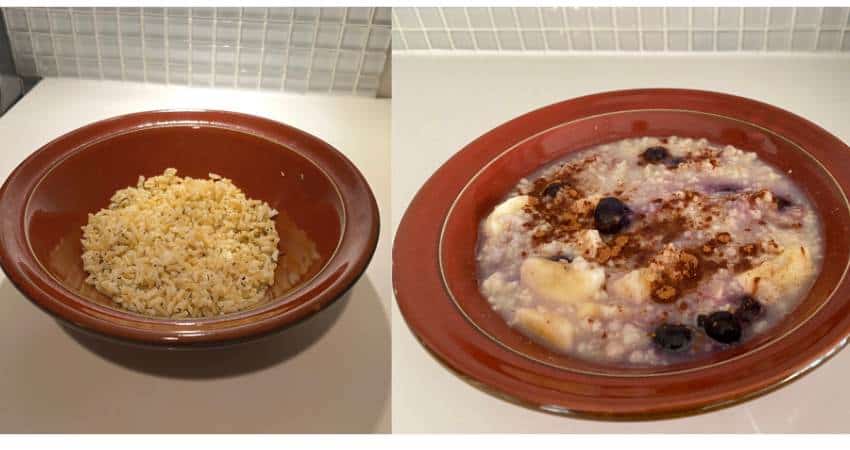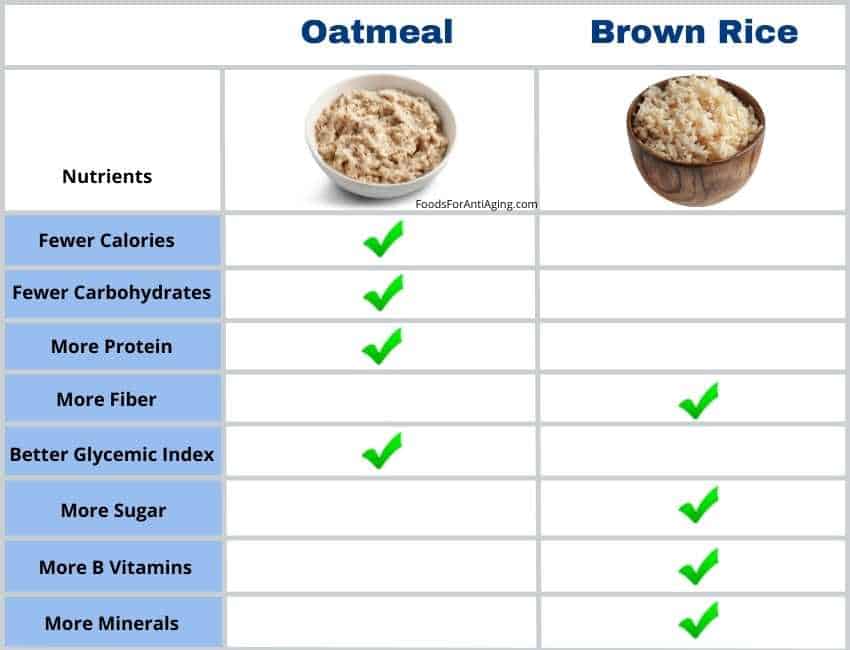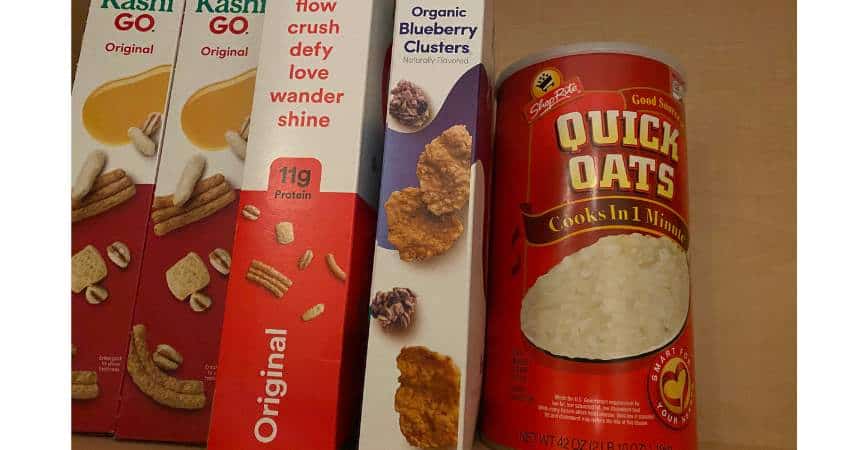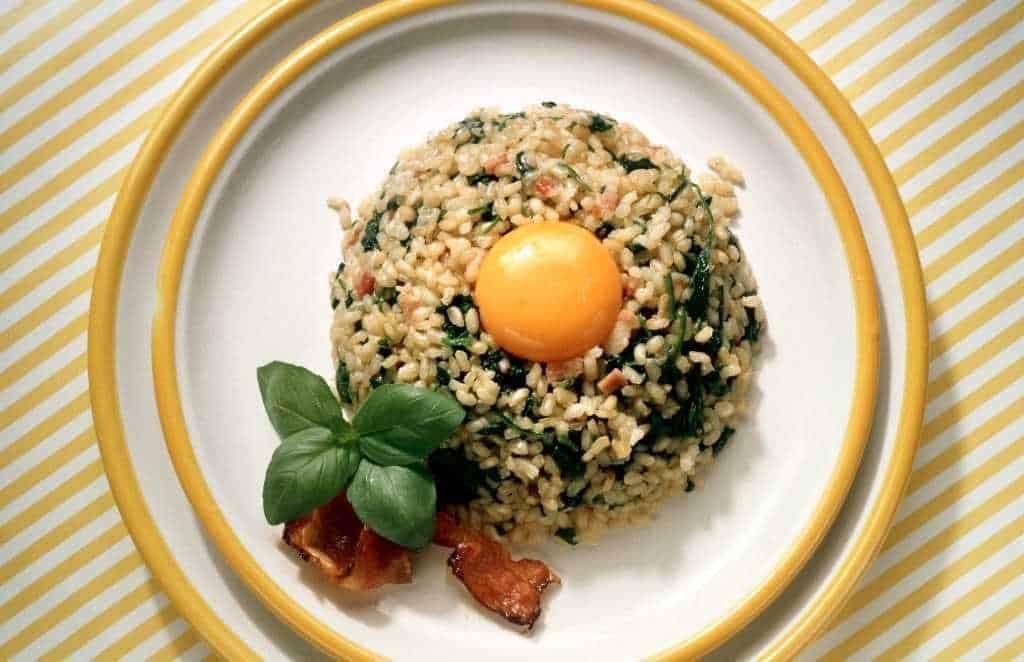Brown Rice vs Oatmeal: Are Oats Better? Let’s Compare
As a Certified Health Coach many clients ask me about healthy foods like brown rice and oatmeal. They both have many nutrients but can differ in the numbers. This causes many people to ask, what is better, brown rice or oatmeal?
Oatmeal is better than brown rice due to its fewer calories, carbohydrates and sugar. It’s better for weight loss due to its fewer calories and better satiety index score than brown rice. Rolled oats glycemic index of 55 is lower than brown rice’s 68 which may aid in better blood sugar control.
This article will include a side-by-side comparison of the nutrients contained in both. In addition, I’ll examine their glycemic index, satiety index, tastes, textures, prices, storage methods and health benefits.
In addition to coaching clients about them, I’ve purchased, researched and consumed both prior to, during and after writing this article. Both foods are part of my own personal nutrition plan.

Brown Rice vs Oatmeal: Nutrient Comparison
They both have similar nutrition profiles, although there are key differences between the two.
The following table is a side-by-side comparison of the nutrients contained in a 100-gram serving of each one.
| Oatmeal (100 g)
Cooked |
Brown Rice (100 g)
Cooked |
|
| Calories | 71 | 112 |
| Protein | 2.54 g | 2.32 g |
| Carbohydrates | 12.0 g | 23.5 g |
| Fiber | 1.7 g | 2.8 g |
| Fat | 1.52 g | 0.83 g |
| Sugar | 0.27 g | 0.40 g |
| Vitamin A | 0 IU | 0 IU |
| Beta-carotene | 0 mcg | 0 mcg |
| Vitamin C | 0 mg | 0 mg |
| Vitamin B6 | 0.005 mg | 0.14 mg |
| Vitamin B9 (Folate) | 6 mcg | 4 mcg |
| Vitamin B1 (Thiamin) | 0.07 mg | 0.10 mg |
| Vitamin B2 (Riboflavin) | 0.01 mg | 0.01 mg |
| Vitamin B3 (Niacin) | 0.22 mg | 1.33 mg |
| Vitamin B5 (Pantothenic Acid) | 0.31 mg | 0.39 mg |
| Magnesium | 27 mg | 44 mg |
| Phosphorous | 77 mg | 77 mg |
| Potassium | 70 mg | 79 mg |
| Iron | 0.90 mg | 0.53 mg |
| Copper | 0.07 mg | 0.08 mg |
| Calcium | 9 mg | 10 mg |
| Zinc | 1.00 mg | 0.62 mg |
As you can see in the table above they both contain the same types of nutrients. At first it’s difficult to determine which one provides a higher percentage than the other. This causes many people to wonder which one is healthier.
Brown rice provides a higher percentage of nutrients making it healthier than oatmeal. It contains a greater number of fiber, B6, thiamin, niacin, B5, magnesium, potassium, copper and calcium than oatmeal.
Oatmeal is healthy too and contains the same nutrients but a little less of them. It has fewer calories, carbohydrates and sugar. It provides a higher percentage of protein, folate, iron and zinc.
Oats or Brown Rice: Which to Choose?
It’s a difficult choice, but choosing between the two may depend on your particular goals. Let’s examine some of the popular goals people have and decide which is better for each one.
Weight Loss and Calories
The most common goal may be weight loss. If you’re looking to shed some extra pounds around the middle, this topic will interest you.
Oatmeal is better for weight loss due to its fewer calories and carbohydrates per serving. For every 100 gram serving, oatmeal contains 58% fewer calories than brown rice. It also has a higher satiety making people feel fuller faster.
Protein
Oatmeal contains slightly more protein than brown rice per serving. It has 2.54 grams of protein per 100 gram serving while brown rice contains 2.32 grams.
Dietary Fiber
Brown rice contains more fiber than cooked oats. It has 2.8 grams of fiber per 100 grams while cooked oatmeal contains 1.7 grams.
Low Carb Diets and Carbohydrates
If you’re on a low carb or Keto diet, oatmeal is the better choice containing 12.0 grams of carbohydrates per serving. Brown rice has 23.5 grams per 100 gram serving.
Bodybuilding and Muscle Fitness
Brown rice is better for building muscle and athletic performance than oatmeal due to its higher percentage of carbohydrates and calories.
The extra calories and protein help to bulk up, build and repair muscle. The extra carbs help to provide energy and increase athletic performance while exercising.
On the days I go to the gym I eat prepared oats more in the morning because I don’t prefer the whole grain for breakfast time. If I went to the gym later at night I’d probably do the opposite.
Glycemic Index
Knowing the glycemic index of food is important especially if blood sugar levels are a concern. Avoiding blood sugar spikes is an important part of consuming healthy food.
The Glycemic Index (GI) is a scale measuring how fast a particular food raises the blood sugar in the blood3.
Foods on the GI scale are categorized as:
- Low-GI foods: 55 or under
- Medium-GI foods: 56-69
- High-GI foods: 70 or over
How blood sugars levels are affected:
- Foods with a glycemic index 70 or more cause a quicker spike in blood sugar levels.
- Foods with a glycemic index 56 to 69 cause a moderate spike in blood sugar levels.
- Foods with a glycemic index 55 or less cause a slow spike in blood sugar levels.
Having more knowledge of the glycemic index of food and how it raises blood sugar, many people wonder which of the two foods has a higher GI?
Oatmeal has a lower GI than brown rice. Rolled oats have a GI of 55. Instant oats has a GI of 79. Steel-cut oats have a low GI under 55. Boiled brown rice has a GI of 68.
Although it has the better score, brown rice is considered a medium-GI food falling into the 56 to 69 range.
Steel-cut oats have a lower GI because they are the least processed. Rolled oats are a little higher because they’ve been partially cooked. Quick oats have been steamed and rolled into thinner pieces to cook quicker. This process increases their GI.
Find out how quinoa compared in my other article here.

Satiety Index
Satiety is a term used to explain the feeling of being full and the loss of appetite which occurs after eating food. The satiety index is a scale showing how full a person feels after eating a certain food.
It was developed in 1995 from a study which tested 38 foods. Thankfully for the purpose of this article, both of the foods we’re concerned about were chosen as two of the 38 foods.
The foods were ranked how they satisfied a person’s hunger. Foods scoring under 100 are considered less filling and foods scoring above 100 are considered more filling ((National Center for Biotechnology Information: A satiety index of common foods)).
The table below shows the satiety scores of various filling foods.
| Food | Satiety Index Score |
| Bananas | 118% |
| Brown rice | 132% |
| Lentils | 133% |
| Wholemeal Bread | 157% |
| Brown pasta | 188% |
| Oatmeal w/milk | 209% |
Comparing the table above will help answer the question, which food keeps you full longer?
Compared to brown rice, oatmeal will keep you full longer due to its higher satiety index of 209%. Brown rice satiety score is 132%.
Of all the 38 foods, it scored the fourth highest only beat by oranges, ling fish and boiled potatoes.
High satiety foods are likely to have a high satiety score for the following reasons:
- High in protein.
- High in fiber.
- High in volume (foods containing a lot of water or air).
- Low in energy density (foods low in calories for their weight).
Prepared oats seems to fit into all four listed above.
Find out if grits has the better satiety in my article here.
The video below teaches you how to make the perfect brown rice.
Oats and Rice: Taste and Texture
Many times people choose one food over the other because of its taste. Since there are some similarities between the two, many people wonder how the two foods foods taste and texture compare.
Oatmeal is blander and has less flavor than brown rice. Cooked brown rice has a nuttier flavor while oatmeal has an earthier flavor. Oatmeal’s texture is not smooth but brown rice is harder and chewier. Cooked brown rice is drier than cooked oats which is more moist or wet.
Brown rice has a nutty flavor and is slightly earthy. Short-grain is a little sweeter and long-grain is woodier and grainer. Long-grain is drier than short or medium-grain.
Old-fashioned rolled oats have a chewier texture than the smoother instant or quick oats.
To conduct some original research, I polled some of my readers and people in food groups I belong to. I asked which of the two foods taste better?
- 45% said they preferred the taste of brown rice.
- 38% said they preferred the taste of oatmeal.
- 17% said it depended on the meal.
For more research on the topic I thought it would be fun to set up my own taste test at home. Both foods were prepared plain. The results were 75% chose the whole grain over the oats.
The whole grain is more versatile and is used more for lunch and dinner while oats is mainly used for breakfast. Some people use both for breakfast with their eggs.
Check out the differences with granola in my comparison article.
Costs
It seems every time I check out at the supermarket the price is higher than the last time and I have less groceries in my cart. The cost of food certainly matters to most, especially with the rising costs of everything.
The price may sway your decision about which one to use in your meals more often. Therefore, let’s take a closer look at the prices of each food.
Brown rice and oatmeal have a similar price per serving. The average price for quick oats is $0.25 per 1/2 cup serving. The average price for brown rice is $0.26 per 1/2 cup serving.
To conduct more research, I decided to visit various different stores to compare the prices of both.
I first visited the Shoprite supermarket and found the following prices:
- Carolina Brown Rice
- $5.99 per 80 oz bag (25 servings) equaling $0.24 per 1/2 cup serving
- Quaker quick oats
- $4.99 per 18 oz container (13 servings) equaling $0.38 per 1/2 cup serving
I then checked Walmart:
- Carolina Whole Grain Brown Rice
- $6.37 per 32 oz bag (22 servings) equaling $0.29 per 3/4 cup serving
- Quaker quick oats
- $4.98 per 42 oz container (30 servings) equaling $0.17 per 1/2 cup serving
- Quaker quick oats
- $2.73 per 18 oz container (13 servings) equaling $0.21 per 1/2 cup serving

How To Store
Whichever you choose or have on hand, proper storage is crucial. How you store food, fruit or vegetables can affect how long they last before going bad and how they taste.
I conduct pantry makeovers with my health coaching clients so the topic of storage always comes up. Therefore, let’s examine how to properly store each one.
The best way to store unopened or opened brown rice is to keep it in a cool, dry place away from the sun or indirect heat. Opened it should be transferred to a tightly covered glass container, plastic container or a resealable bag. Uncooked it does not have to be refrigerated.
Even though it’s not required, opened brown rice may be stored in the refrigerator in an airtight bag or container up to 12 months.
Uncooked it may be frozen up to 12-24 months in an airtight bag. Remove as much air from the bag as possible.
The best way to remove the excess air is to use a vacuum sealer. They are one of those items making you wonder how you did without one before purchasing it.
Store cooked brown rice in a sealed container in the refrigerator up to 4 days. Do not leave it out of the refrigerator for more than two hours4.
Store unopened dry oats in a cool, dry place away from the heat and sun. Opened it should be tightly covered in its original container, glass or plastic container or resealable bag. Opened, uncooked does not have to be refrigerated.
Opened it can be stored up to one year. Always check the dates on the packaging. Typically, the “best if used by date” is a quality suggestion5.
At home I store my oats in a kitchen cabinet away from heat and light. It always keeps it fresh and I never have any quality issues.

Find out how white rice compared to oats in my article here.
Health Benefits
The health benefits of each one are similar. They contain the same nutrients but in slightly different percentages. Let’s take a look at the benefits the nutrients provide.
Fiber
- Brown rice contains 1.1 grams more per 100 grams.
Both foods are high in soluble fiber, which is helpful for many reasons ((National Center for Biotechnology Information: Mechanisms linking dietary fiber, gut microbiota and colon cancer prevention)). What makes fiber soluble is it dissolves in water.
Soluble fiber is known for the following:
- Help overall digestive health.
- Decrease the risk of diabetes by managing the blood glucose levels.
- Helps avoid constipation and have a more regular stool.
- Aids greatly in weight management because it allows you to feel full faster and eat less.
Magnesium
- Brown rice contains 17 mg more of magnesium per 100 grams.
Magnesium helps keep blood pressure levels stable and balanced. Recent scientific research examined previous studies and concluded magnesium supplementation decreased systolic and diastolic blood pressure6.
Magnesium helps control the following:
- Blood pressure
- Blood sugar
- Muscle
- Insomnia
- Nerve function
One reason many people supplement with magnesium in the evening is because it helps calm the whole body including blood vessels.
In the heart and muscles, magnesium competes with calcium to help the muscles relax after contracting. When the body is low in magnesium, calcium can over stimulate the heart muscle’s cells causing a rapid or irregular heartbeat ((National Institutes of Health: Magnesium)).
Is eggs better for breakfast? Find out in my article here.
Potassium
- Brown rice contains 9 mg more of potassium per 100 grams.
Potassium helps the body get rid of excess sodium reducing fluid build-up. These help keep systolic and diastolic blood pressure lower ((American Heart Association: How Potassium Can Help Control High Blood Pressure)).
According to Harvard Health, a number of studies have shown a connection between low potassium levels and high blood pressure7. The more potassium, the more sodium your body will lose.
Consuming too much sodium or not enough potassium throws off the delicate balance the kidneys need to remove the excess water8.
Phosphorus
- Both foods provide the same amount of phosphorus per 100 grams.
Phosphorus has been shown in scientific studies to help with the following:
- Promote healthy nerve conduction.
- Promote bone and teeth strength.
- Help the body store and manage energy.
- Muscle contraction.
- Muscle recovery.
- Help the kidneys remove waste.
Calcium
- Brown rice contains 1 mg more of calcium per 100 grams.
Calcium is important for the heart and blood pressure. Harvard Health reports calcium helps maintain blood pressure by helping in the controlling of the relaxing and tightening of blood vessels9.
Calcium also helps the following:
- Helps nerve function.
- Help the muscles to function properly.
- Build and maintain strong bones.
Is there a difference between overnight oats and regular cooked? Find out in my article.

Iron
- Oats contains 0.37 mg more of iron per 100 grams.
Much higher in iron than other grains, it is an excellent choice if you need to get your daily value of iron. Iron is essential in the creation of red blood cells and is a necessary part of any healthy diet.
It is also vital for growth and development, as some hormones need it to be appropriately balanced10.
B Vitamins
Of the six B vitamins listed below, brown rice provides a higher percentage of four of them.
The B vitamins provided include the following:
- B1 (thiamin)
- B2 (riboflavin)
- B3 (niacin)
- B5
- B6
- B9 (folate)
B vitamins help support the following:
- Cardiovascular disease.
- Red blood cells.
- Digestion.
- Brain function.
- Nerve function.
- Energy levels.
A lack of B vitamins has been associated with oxidative stress and neural inflammation. In a study released in 2018 32 healthy adults were given B vitamin supplementation for six months. The results indicated preliminary evidence B vitamin supplementation reduced oxidative stress and inflammation11.
I compared everything with Cream of Wheat in my article here.
Gluten-Free
Brown rice and oats are naturally gluten-free and might be a great substitute to other gluten-heavy items of a similar taste. Even those who don’t have a completely gluten-free diet may benefit from cutting down on their gluten.
Recently it has been discussed many more people have at least a small amount of gluten intolerance and are unaware of it. Having less gluten in your diet is a good choice for most.
Important: Although they are gluten free, they may come in contact with gluten-containing grains in storage or during transportation. Most of the Quaker oat products have solved this issue and label those products gluten free. Always check the label of your food to determine if its gluten free.
Saturated Fat
Saturated fat is one of the dietary fats. Along with trans fat, it is an unhealthy fat which large amounts should be avoided when possible.
According to The American Heart Association, it can cause problems with bad cholesterol levels which may increase your risk of heart disease.
The whole grain and oats compared in this article are low in saturated fat. Using both in a diet low in these fats is another health benefit.
If you have any questions about this article don’t hesitate to email us. You can find an email on our contact page.
Read Next – More Food Articles!
Brown Rice vs White Rice: Which is Better? Let’s Compare
Couscous vs Rice vs Quinoa: Which is Better? Let’s Compare
Brown Rice vs Quinoa: Which is Better? A Complete Comparison
Muesli vs Oatmeal – What’s The Difference? Let’s Compare
Oatmeal vs Porridge: Are They The Same?
Oatmeal Vs. Oat Bran: A Comparison
Bread vs Oatmeal: Which is Better? A Complete Comparison
Oatmeal vs Cereal – Which is Better? Let’s Compare
- USDA: Cereals, oats, regular and quick, unenriched, cooked with water (includes boiling and microwaving), without salt [↩]
- USDA: Rice, brown, medium-grain, cooked [↩]
- Harvard Health Publishing: Glycemic index for 60+ foods [↩]
- University of Nebraska-Lincoln: Now, You’re Cooking with Brown Rice! [↩]
- Michigan State University: Dry oatmeal needs careful handling [↩]
- National Center for Biotechnology Information: Effect of magnesium supplementation on blood pressure: a meta-analysis [↩]
- Harvard Health: Potassium lowers blood pressure [↩]
- National Center for Biotechnology Information: The Effect of the Sodium to Potassium Ratio on Hypertension Prevalence: A Propensity Score Matching Approach [↩]
- Harvard Health: Key minerals to help control blood pressure [↩]
- National Institutes of Health: Iron [↩]
- National Center for Biotechnology Information: The Effect of a High-Dose Vitamin B Multivitamin Supplement on the Relationship between Brain Metabolism and Blood Biomarkers of Oxidative Stress: A Randomized Control Trial [↩]
